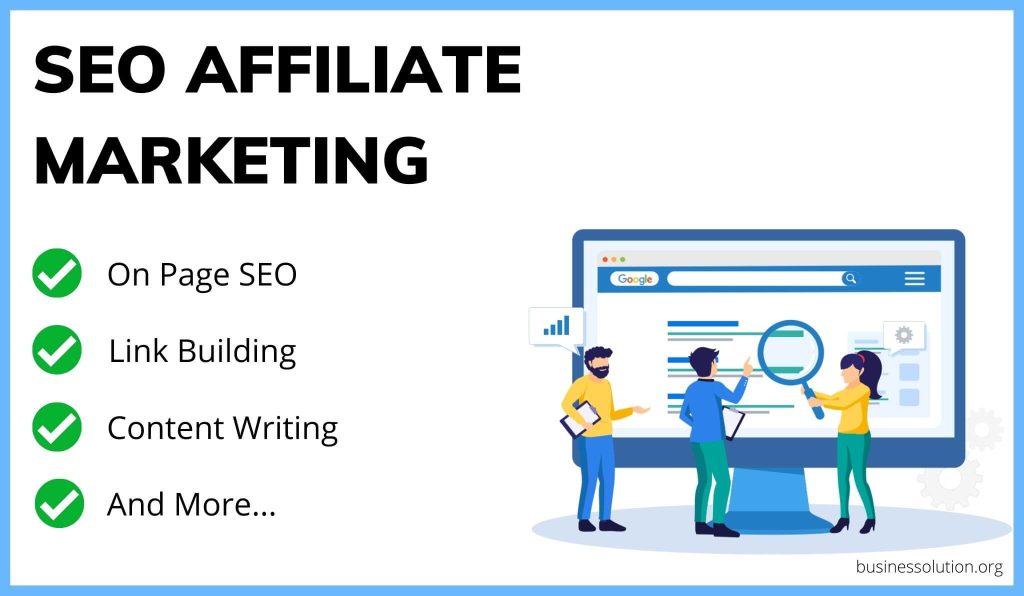Today you’ll learn everything you need to know about SEO affiliate marketing. From audience and topic research to keyword research to writing content to link building.
I wanted this guide as accessible as possible so I’m going to show you today is a process of SEO optimization your affiliate marketing website using only free tools.
The free tool method that I’m going to demonstrate is very effective and this is how I got started as an affiliate marketer blogger.
Table of Contents
SEO Affiliate Marketing Process
Here is what we’re going to be covering in this SEO affiliate marketing guide:
- Audiene research
- Topic research
- Keyword research
- Outline creation
- Writing content
- Editing article
- SEO on page optimization
- Content promotion
- Link building
So this is the complete SEO affiliate marketing process and you might be able to add steps to this.
A lot of SEO experts are very fond of breaking things down into many steps into getting really analytical. They just, break it down to the point where it’s almost more complicated than it needs to be.
So hopefully I haven’t done that here but I wanted to make sure I covered all the bases. But keep in mind that this is a very long and labor-intensive process, especially until you get good at it.
And that’s one of the reasons that I recommend using the premium tools that we’ll cover in this affiliate marketing SEO guide.
It’ll save you a lot of time and effort and allow you to really scale your content production, but we’re going to start with the free process.
So without further ado, let’s get into step number one.
1. Audience Research
So step one is audience research, and this is really important. This often doesn’t get covered in SEO tutorials, but it is a very important part of affiliate marketing and SEO.
So the first step is to create your customer avatar or your target audience.
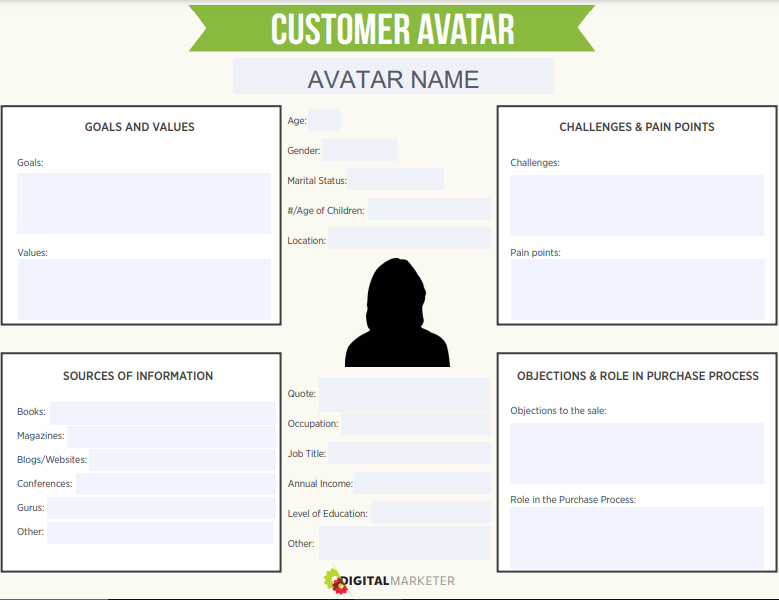
And basically what this means is that you need to really understand the person or people to who you’re trying to market in your affiliate marketing blogging business.
So presumably if you’re writing blogs and you’re doing so in a professional business context, you’re either trying to sell your own products or services or in this case, you’re trying to sell an affiliate product or service. There are really not many other reasons that people consistently write high-quality affiliate blog posts.
And so in order to create content in order to write a blog post or an article that’s actually going to motivate people to buy what you’re promoting you need to really understand who they are and what they need.
So how do you do that?
Join Communities
Well, the first step I like is to join communities your target audience or your customer avatar is involved.
So my recommended resources for this step are:
- Quora
- Forums
And other places that your target audience hangs up.
Get The Product Your Want To Promote
You can also buy the products that they love, which is really good because that allows you to go through the sales funnel for the product and see how it’s being sold.
And it also lets you experience the product and understand why they might like it. You can also read product reviews on websites like Amazon, AppSumo if you’re promoting software.
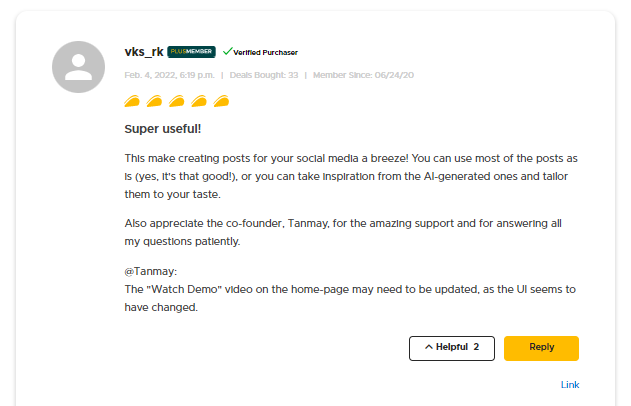
If there’s an online course related to your niche then you could read reviews on a site like Udemy and basically, you want to walk a mile in their shoes.
Join Email List of Your Competitiors
You can also sign up for mailing lists that they’re likely to be on. So simply go to websites they’re likely to visit, sign up for the email lists, and see how other marketers are communicating with them.
2. Topic Research
Before you can write content for your affiliate marketing website, you must understand the topic. And if you don’t understand the topic, you’ll waste time and you’ll turn your fact-checking process into a laborious nightmare.
So I really recommend that you do some topic research before you even consider getting into writing on a topic.
And the thing is that if you understand a topic, you’ll be able to create better content than anyone who has less knowledge than you.
I’m not saying you will create the best content on the internet. I’m saying that you will be capable of creating better content than people who have less knowledge.
And this is one reason why specializing or niching down choosing a specific niche and staying in it is a good one.
And my recommended resources for this section are:
- Google search
- Google Trends
- YouTube
- Quora
- Online communities
And other sources of information to learn about whatever topic it is that you may want to research.
I’m sure that you know how to do general topic research.
3. Keyword Research
Ranking your content can be a tough business without the right keyword research process. The goal of keyword research is to find popular search terms that are related to what you are selling.
This allows for better visibility on the web, which will help you reach more potential customers. To successfully do keyword research, there are some important tips you should keep in mind.
So right now I’m going to share with you some quick tips to get you started but if you want to see a process how to do it the right way I’ve put together a step by step guide on affiliate marketing keyword research where I describe in detail 5 ways to perform keyword research using only free tools.
Keyword Search Volume
You want to make sure your keywords have enough demand so that they bring traffic to your site. If not, then it’s a waste of time doing them.
Competition
In addition, you also need to know how much competition there is for each term. This will help determine if it makes sense to invest money in SEO.
For this, you can use some of the affiliate marketing spy tools to see what your competitors are doing.
If you take your time and follow these strategies for finding profitable keywords, you will see an increase in sales and revenue over time.
Head Term vs Long Tail Keywords
Long-tail keywords tend to get less search volume but usually higher conversion rates than head terms since. They’re often very specific and target niche audiences so these are more likely to convert into sales or leads.
Head term broad keyword phrases may take longer to rank on SERPs because they carry much weight on search engines.
So when choosing which ones to focus on, make sure they fit with what you want to achieve from an ROI perspective.
Avoid Keyword Over Optimization
When it comes to keyword optimization you have to keep in mind that there is such a thing as over-optimization.
And what I mean by over-optimization is that it’s possible to use a specific keyword or a group of keywords too frequently in an article. And then Google and other search engines will consider it keyword stuffing, and they’ll deprioritize it in the index.
If you want to do keyword optimization manually to an already written article is you just go through the article and you try and find opportunities of places where you can use those keywords.
💡 Pro Tip
If you want to do advanced keyword optimization, it is much, much easier when you use a premium tool like WriterZen which is a really powerful keyword research and content creation software that costs a lot less than most premium SEO tools out there.
4. Article Outline Creation
Let’s move on to the next step which is outline creation. So a good outline will set you up for success and reduce the amount of time that you need to spend on writing your affiliate articles.
Structure Your Article
You should have only one H1 in your article and it should be your main topic including the main keyword.
For example, my H1 and title tag for this article is affiliate marketing SEO.
Your H2s should be subtopics of the main topic and should include relevant keywords as well. Not always, but in general, it’s a good idea for most of them too.
And your H3s should be sub subtopics, also known as subtopics of the subtopics, which helped to provide more information and more context about the things that you’re talking about in your H2s as you can see here from the SemRush article on how to use header tags for SEO.
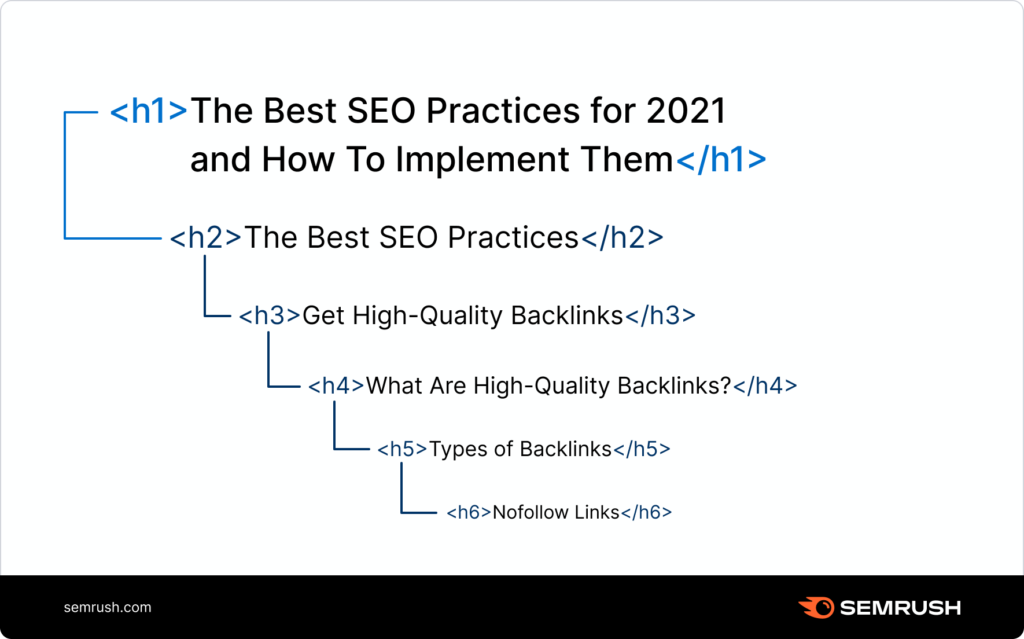
And if it makes sense for the flow of the article, it’s a good idea to have high-volume search terms, high volume keywords used in your H2 and H3s.
And the more that you put them towards the top of the article, the more there’ll be a priority.
For example: “Affiliate Marketing SEO: The Ultimate Guide” would be better than the “Ultimate Guide To Affiliate Marketing SEO” because the main keyword is in front of the title.
But don’t do that in a way that sacrifices the article’s flow or the article’s overall quality. So don’t sacrifice readability or quality just to trim keywords. That’s not what you want to do.
Create Complelling Title To Improve CTR
And another really important note is to put some effort and thought into your title to improve your click-through rate.
It’s really important because if you don’t have a good title no one’s going to want to read the rest of the article.
Here are some tips to get you started:
- Use numbers in your headline
- Ask a question to spark quriosity
- Use emotion and power words
- Determine the benefits for the readers
- Use data to to make your article more enticing
And when you’re creating an outline, you want to make sure that you get it right, but you don’t want to spend too much time here because otherwise, you can start to suffer from paralysis by analysis and that is not what we want.
All right. Let’s move on to the next step which is article drafting.
5. Writing Affiliate Content
Now, this is where you actually get to do some writing. And here you want to choose the type of content based on search intent:
- Product reviews
- Product comparisions
- Listicles
- How to articles
- PDFs
You can also create a video if you’re trying to rank your videos higher on Youtube or Google.
And different people have different approaches to content writing.
I prefer to write with a top-down method, for the most part, meaning I start with the hook and the introduction, and then I go to my first H2, and then I do any subtopics of that in H3s.
And I just work my way down, writing the article in kind of the logical order – the order that people are most likely to read it in.
If I have an idea for something that comes further down into the article, I won’t hesitate to jump down and work on it, but then I usually go back and continue working down in a top-down way.
For me, that’s just the most logical and the easiest way to do it but if you find that it makes more sense to write certain parts first, go ahead and do that.
There’s no 100% percent right way to write an article.
Include Main Keyword in Your Title Tag
And you can try to use the keywords from the headings in the main content as well.
So for example, if I want to use “how to start affiliate marketing for beginners”, ideally, I should use all of those keywords at some point in the main content, not just in the heading.
And then in the main content, you also want to use any keywords that you weren’t able to use in the headings.
And just a couple of general notes about content writing.
Use Short Paragraphs & Structure Data
You want to use short paragraphs punchy sentences where possible and have structured data such as lists and tables to break things down and make it easier to look at and easier to absorb the information.
People who skim through articles tend to have a much easier time with shorter paragraphs and with tables and lists so those are really good things to include.
Implement Copywriting Formulas
Remember each section is responsible for getting the readers to continue to the next section and the next sentence. So make sure that it has a logical flow to it. And for this, you can use some copywriting frameworks like:
- PAS
- AIDA
- BAB
- The 4 C’s
- The 4 U’s
Article Writing Resources
And my recommended resources here are just Google docs and Google sheets. You can get a premium Google Workspace account which is better than just a regular free Gmail Google Drive account, but you can also use this 100% for free.
💡 Pro Tip
If you’re struggling to write content for your affiliate site, you can use tools such as Jasper.ai which is the best AI writer available in the market, or Article Forge 3.0 which is an article generator that can spit out an entire article from just a headline.
6. Article Editing
So once you have your document written, it’s time to move on to editing your affiliate article. And for this, I recommend Google docs still and Grammarly, and the Hemingway app.
And while I think it’s important to use these apps, keep in mind, the editing is not just about scoring high on Grammarly or Hemingway. Editing is not about pleasing an app.
Editing is about creating an article that people human beings will enjoy reading and will get engaged when they read because if they don’t get engaged when they read it, they’re probably going to stop reading it.
And because of this, I always recommend reading out loud to newer writers and I often recommend it to experienced writers because if you read your content to yourself out loud, it really helps you get a feel for the flow and the sound and the tonality.
And that’s going to make it easier for you to really do a good job of editing it and create a finished product that people are going to have an easy time reading.
Hemingway App recommends a whole slew of different corrections, such as passive voice, how to simplify phrases, how to make things easier to read, how to use fewer adverbs, stuff like that.

Then Grammarly is more of a spelling and grammar checker, but it also has on the premium version a plagiarism checker, which is great.
And if you have Grammarly premium or you have access to another plagiarism checking tool, then I highly recommend at the end using the plagiarism check tool.
But as long as you’re sure that you’re writing original content, this isn’t strictly necessary, but it is a good idea to check for plagiarism, even if you’re pretty sure.
That even if you know that everything you wrote is your own writing, you might have inadvertently mimicked something that you read or you might have just completely by chance written something very similar to something that someone else wrote so it’s always a good idea to do a plagiarism check.
7. SEO On Page Optimization
Now we’re on to the next step which is SEO on-page optimization of your article.
Ever wondered why your web page looks like it ranks well for a specific keyword but never shows up on Google?
Well, it’s because you need to optimize your article for on-page SEO and is the process of improving the visibility of a web page in search engine results directly on your website.
But where does one start?
The first step for on-page optimization is to publish your article. You can’t optimize what’s not there yet. For effective publishing, you need a website.
For this, you can use some of the affiliate marketing website builders or CMS like WordPress which is free to use however, you need to have premium hosting
If you’re using WordPress, you also want a good theme because if you have a good WordPress theme, it’ll present the content in an appealing and easy-to-read format basically automatically.
The themes that I recommend are Astra, Kadence, or Thrive Themes that many affiliate marketers use.
Include Images, Videos, and Audio
When publishing your content it’s important that you include images and video and audio elements where appropriate.
So images and videos, and even audio can help you rank, but they also really help improve the user experience because the thing is some people who are going to find your blog post would probably rather watch a video or listen to audio.
Some people just prefer that even if they go to a blog post expecting to have to read it if there’s a video or audio there, they’re going to enjoy that more. And that’s going to make them more engaged.
It’s going to make them more likely to stay on the page, which is good for affiliate marketing SEO.
And ultimately it’s going to make them more likely to buy whatever you’re promoting, which is the end result that we’re going after.
Take Advantage of Internal Linking
Also when you’re publishing, you want to link internally to relevant resources and the products or services on your website that you’re promoting.
So internal links are very important for SEO. You want to have internal links going from your post to other pages on your website, and you want to have internal links going from other pages to your new posts, but it’s important that you only use internal links where relevant.
For example, if I’m writing an article about “how to start affiliate marketing for beginners”, and I have an article on my blog about “affiliate marketing strategies” if there’s a section in my article on “how to start affiliate marketing for beginners”, where I talk about affiliate marketing strategies, it would make sense to link from that section to my other articles.
And the same applies to internal links that are coming from other posts to your new posts.
Now, if you want to get really into how internal linking works and best practices for it, I recommend that you watch this video from Ahrefs.
Link Externally To Relevant Resources
And for external links, you just want to make sure that you’re only linking to really relevant and authoritative resources, for example, one thing can do is it in my article on affiliate marketing SEO, I could link to like a Wikipedia page or another really high authority website that explained what SEO is.
And of course, if you’re doing an affiliate post, you can also include external links to the affiliate product, just to make sure that you are setting those external links to affiliate products, to no follow and to sponsor because that’s what the search engines want you to do. And they may deprioritize you a little bit if you don’t do that.
Submit Your Post To Google Search Console
And once all that’s done, once the post is beautifully published on your website. then you can submit the URL to Google Search Console.
You can just come to the Google Search Console, you paste the URL that you want to index. It’ll bring up a page like this.

Then you click on “Request Indexing”, and that is basically the fastest way to get your article indexed quickly.
8. Content Promotion
Once your article is published on your affiliate marketing website, now we are onto the final step which is promotion. Now a lot of search engine optimizers seem to forget that this exists and it really hurts them.
Share Your Content on Social Media
The first thing you can do to promote your content is to share it on social media. This will help increase the number of people who see and read your article, which in turn increases its chances of being shared by others.
You should also use a variety of different platforms like Facebook, Twitter, or Pinterest so that your audience has as many opportunities as possible to view your work. The more places they have access to your content, the better chance there is for them to find it.
Promote via Email Marketing
Affiliate email marketing can also be a great tool when promoting your site. You can send an email broadcast announcing upcoming events, special offers, etc., which could lead to more traffic coming to your site. Make sure that these emails don’t contain any spammy content though; otherwise, they may end up being flagged as such by some of your subscribers.
Leverage Paid Advertising
If you have a budget, then consider using some form of paid promotion. There are many different ways to do so, but some of the most popular options right now are Facebook ads or Google ads. These can be used to target specific groups or demographics within your audience.
Read more: Paid Traffic For Affiliate Marketing in 2022 | +14 Best Traffic Sources
Syndicate Your Content
You can also use platforms like Medium to syndicate your articles across multiple websites. When someone shares one of your pieces on their site, it helps drive traffic back to your own page. The best part? It doesn’t cost anything extra to do so.
Read more: Medium Affiliate Marketing 2022: Best Tips & Strategies
Get Featured on Other Sites
Another way to get exposure for your blog or website is through guest blogging. By writing an original post about something related to your niche, you’ll be able to attract new readers from all over the world. If you want to make sure that this strategy works well for you, try to write posts with unique angles and perspectives.
Take Advantage of Cross Promotion
And finally, you can leverage cross-promotion, and what I mean by cross-promotion is just getting other people to promote your content in exchange for you promoting their content.
Now, you don’t want to do this at scale. You don’t want to be like someone who will promote anyone in exchange for them promoting you. But if you have some friends who are in the same industry as you and you get along with them, there’s no reason for you not to share theirs and then not to share yours, it’s going to help you both grow.
So that is a content promotion in a nutshell for SEO affiliate marketing.
💡 Pro Tip
For promotion and just for posting to my own social media, I use Ocoya, which is not just a scheduling tool but an all-in-one social media platform that also includes graphic creator, tracking, as well as AI copywriting tool for your social media captions. It integrates with social media platforms including Pinterest, Instagram, Facebook, Google My Business, Twitter, and all of the major social media sites. So it makes it really easy to just share your posts every day on a schedule and you can kind of set that and forget it.
9. Link Building
Let’s talk about link building today. And because links lead to better rankings and rankings lead to more traffic, and traffic generally leads to more money.
What you have seen in the past is you’ve seen actual services that allow you to do things like buy links and buy guest posts and do some things that are a clear violation of Google’s terms of service.
And just to be clear for this link building for affiliate sites model, we’re talking about only the white hat SEO which is essentially just following the Google terms of service, producing a better experience for the user, producing better content, and ranking naturally as a result.
Black hat SEO methods involve buying links, link farms, and anything in between.
You’ve got things like private blog networks or PBNs that have sprung up over the years where people build these giant networks of content sites that have a bunch of junky content on them and they eventually cross-link them all in some fancy way, all the way back to the money site or whatever.
All of these are examples of link schemes that have worked in the past and may still work today but it’s not a great way to build a sustainable search marketing practice.
It’s really getting harder and harder to wear the black hat.
I keep coming back to this quote from Matt Cutts the former head of search quality at Google:
The objective is to not “make your links appear natural”; the objective is that your links are natural.
So any sort of manipulation that you’re doing needs to be really nice and above the board and not feel spammy at all.
Link Building – Quality Over Quanity
Today links are about quality over quantity. So links from big, authoritative sites like the newyorktimes.com or university sites are always great to get links from.
And the premise here is any link coming off of authoritative websites, the search engines have deemed these as being sites that would never link to something spammy.
And remember that one of Google’s main objectives is to remove spam from its index so that it doesn’t serve spam to its user so that the user stays on the site longer and uses Google more so that.
So they are purging as much as they can any spam from their index and anybody that’s getting a link from these really reputable sites is very unlikely to be a spammer.
Relevance Over Quanity
In this example, you have the Huffington Post vs TechCrunch linking to a software startup company called Slack.
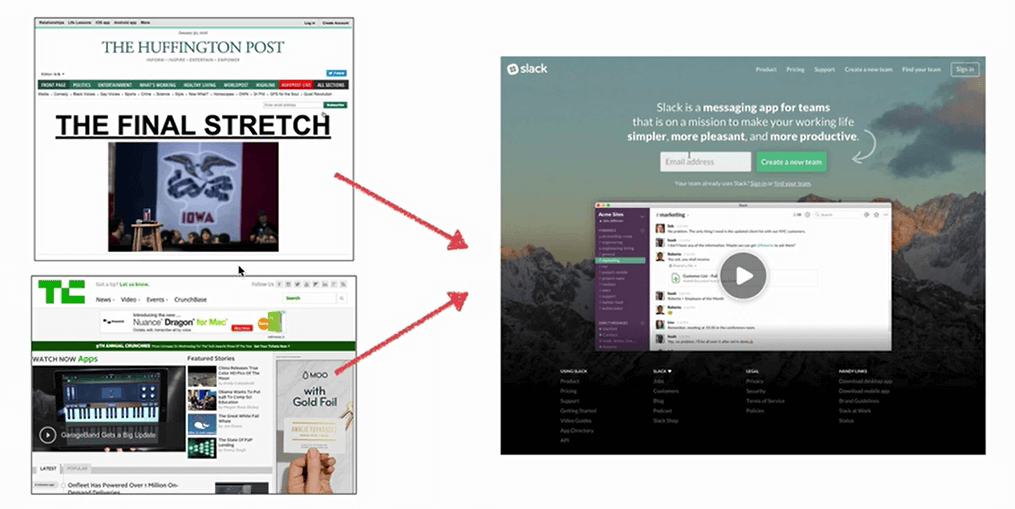
So Huffingtonpost really strong site and TechCrunch less powerful site and it’d be great to get a link from Huffington post if you’re a software company, but probably even better to get that link from TechCrunch because it’s more relevant.
Tech crunch is more about software startup space than a Huffingtonpost is. So if I was Slack I would rather receive this more relevant link from TechCrunch than receive, a link from the Huffingtonpost, but if I could, I’d get them both.
Follow Over No-Follow
Links that come off of pages that have the meta content equals no-follow tag on them are not going to pass as much or maybe zero what we call link juice to you.

If you see a link with no follow tag that means they are essentially telling the search engine don’t follow this link. Don’t interpret this link as me vouching for that site.
You’ll see these no-follow links being used on things like social media sites. For example sites like Twitter is not going to allow us to spam up Twitter with links just to get, you know, more links.
So what they do is they add that no-follow tag and that reduces the spam big-time that’s going through Twitter.
If Twitter links were follow links, there would be significantly larger amounts of people on their links back to Twitter.
Same with comments. By default when you leave comments on a WordPress site, generally, they’re going to link up your name with whatever website and those links will be no-followed so essentially there are worthless for link building for affiliates sites.
You can change that if you want and allow followed links from your comments but in an effort to reduce link spamming because it became very easy to find WordPress sites that allowed you to just comment and drop links into those comments.
So you’re looking for followed links. You’re looking for relevance, you’re looking for quality, um, and last, but certainly still important is the quantity of the links that you have.
💡 Pro Tip
Check out this Link Building For Affiliate Sites guide to discover the 11 best ways to get links for your website.
Affiliate Marketing SEO Tools & Resources
And now we are on to the final page of this tutorial which is how to speed up the process with premium SEO tools.
- BuzzSumo – Topic research tool
- Jasper AI – AI writer powered by GPT-3
- Article Forge 3.0 – Article generator (SEO friendly)
- WriterZen – Keyword research tool
- SemRush – All in one SEO platform
- Thrive Themes – WordPress page builder and lead generation tool
- Ocoya – Content creating & promotion tool
So these are the SEO tools I use in my affiliate marketing business. Of course, you don’t need to use any of them, you can do your SEO for affiliate marketing for free but if you want to save plenty of time, then I highly recommend checking out some of these tools especially some of the content writers since content writing is the most time-consuming part.
SEO Affiliate Marketing Final Words
So that is how to do SEO affiliate marketing. Now you know how to do topic and keyword research, write SEO-friendly articles, promote your content using many different methods, and all of that using only free tools.
This is a process that I have been using for many years now to write and optimize SEO articles that actually rank on Google and on other search engines.
So if you’re just getting started as a blogger, or even if you’re a little bit of a more advanced user, but you’re struggling to get traffic from SEO, I hope this is going to be really helpful to you and you got a lot of value out of that.

